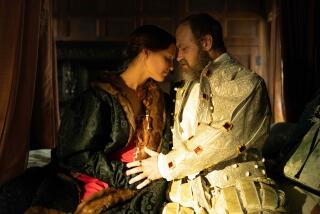Not Just for Kids: ‘Gilt’s’ 16th century dangerous liaisons
- Share via
Gilt
A Novel
Katherine Longshore
Penguin: 416 pp., $17.99, ages 12 and up
King Henry the Eighth,
to six wives he was wedded.
One died, one survived,
two divorced, two beheaded.
If there’s anyone in history who personifies the treacheries of marriage, it’s King Henry VIII of England, who is best known for the beheadings he inflicted during a reign of nearly 38 years. What led to such a barbaric punishment for the sexual indiscretions of his betrothed is the central theme of “Gilt,” which tells the fictionalized history of wife No. 5: Catherine Howard, “the forgotten daughter of the forgotten third son of the man who had once been Duke of Norfolk,” writes novelist Katherine Longshore.
In a book that reads like a more literary version of”Gossip Girl”overlaid onto 16th-century England, “Gilt” tells of Catherine, or “Cat,” from the perspective of her friend Katherine Tylney, a.k.a. “Kitty.” The book begins in 1539, when Cat and Kitty are boy-curious 14-year-olds who spend their days toiling as maids for Cat’s grandmother and their nights illicitly partying with male suitors.
Cat isn’t yet queen of England, but she “set the standards, guided the aimless and judged the unworthy.” Refusing her was like refusing the king, says Kitty, who plays the subservient sidekick to Cat’s mean girl. Cat has no qualms about overfilling a rival maid’s chamber pot, hoping to see it spill, or rubbing rancid fat in another girl’s bedding. Demonstrating a dynamic that’s likely to resonate with teen readers, Cat’s intent on burnishing her image as the curvaceous and coquettish Queen of Misrule, a feat in which she is aided and abetted by her homely gal pal Kitty.
Cat doesn’t believe in love — just social advancement and sexual gratification. Kitty, meanwhile, dreams of circumventing the social confines of her era and choosing a partner for love instead of being “bound to the life we all know would claim us eventually. The dullness of the marriage bed. Compensating with accessories.”
Both eventually find romantic opportunities in the court of King Henry VIII, whose queen, Anne of Cleves, selects Cat to help staff her household. The ever-Machiavellian Cat promises Kitty she will send for her, which she does a few months later, once the buxom teenage Cat has won the affections of the 50ish king. Cat is counting on Kitty to provide social cover by keeping secrets so she can have her cake and eat it too — remain queen of England and also fool around with younger, more virile men. She demands loyalty from Kitty and belittles her into thinking she’s nothing without Cat.
In modern times, Cat would most likely be a cheerleader; the king, captain of the football team. But the royal backdrop with historical underpinnings makes a far more interesting story.
Longshore is “a little obsessed with English history,” she writes in an author’s note, and it shows in the era-appropriate details she works into her text. Readers can practically feel the embroidered ball gowns and hand-stitched lace. They can almost smell the “greasy ... cheese mingled with ... sweat and wet shoes.”
Longshore seems cognizant of her young audience, writing with language that feels modern even if the context is not. The philandering Cat justifies her adultery by describing the king as a “lame old fat man.” She and Kitty occasionally curse.
The framework of “Gilt” is the eventual beheading of Cat and the dangerous liaisons that led to it — so there is, by necessity, sexual content. But it isn’t too overtly graphic or overshadowing of the larger, more compelling story of Kitty, who finds the courage to cast off the shackles of an oppressive friendship and stand in her truth once she recognizes that living the dream of royalty also means living a lie. For Kitty, that truth is revealed through a very public comeuppance orchestrated with an ax.
More to Read
The biggest entertainment stories
Get our big stories about Hollywood, film, television, music, arts, culture and more right in your inbox as soon as they publish.
You may occasionally receive promotional content from the Los Angeles Times.










